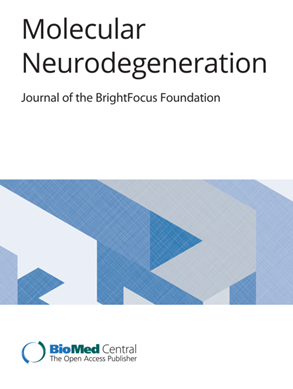TDP-43 seeding activity in the olfactory mucosa of patients with amyotrophic lateral sclerosis
IF 17.5
1区 医学
Q1 NEUROSCIENCES
引用次数: 0
Abstract
In recent years, the seed amplification assay (SAA) has enabled the identification of pathological TDP-43 in the cerebrospinal fluid (CSF) and olfactory mucosa (OM) of patients with genetic forms of frontotemporal dementia (FTD) and amyotrophic lateral sclerosis (ALS). Here, we investigated the seeding activity of TDP-43 in OM samples collected from patients with sporadic ALS. OM samples were collected from patients with (a) sporadic motor neuron diseases (MND), including spinal ALS (n = 35), bulbar ALS (n = 18), primary lateral sclerosis (n = 10), and facial onset sensory and motor neuronopathy (n = 2); (b) genetic MND, including carriers of C9orf72exp (n = 6), TARDBP (n = 4), SQSTM1 (n = 3), C9orf72exp + SQSTM1 (n = 1), OPTN (n = 1), GLE1 (n = 1), FUS (n = 1) and SOD1 (n = 4) mutations; (c) other neurodegenerative disorders (OND), including Alzheimer’s disease (n = 3), dementia with Lewy bodies (n = 8) and multiple system atrophy (n = 6); and (d) control subjects (n = 22). All samples were subjected to SAA analysis for TDP-43 (TDP-43_SAA). Plasmatic levels of TDP-43 and neurofilament-light chain (NfL) were also assessed in a selected number of patients. TDP-43_SAA was positive in 29/65 patients with sporadic MND, 9/21 patients with genetic MND, 6/17 OND patients and 3/22 controls. Surprisingly, one presymptomatic individual also tested positive. As expected, OM of genetic non-TDP-43-related MND tested negative. Interestingly, fluorescence values from non-MND samples that tested positive were consistently and significantly lower than those obtained with sporadic and genetic MND. Furthermore, among TDP-43-positive samples, the lag phase observed in MND patients was significantly longer than that in non-MND patients. Plasma TDP-43 levels were significantly higher in sporadic MND patients compared to controls and decreased as the disease progressed. Similarly, plasma NfL levels were higher in both sporadic and genetic MND patients and positively correlated with disease progression rate (ΔFS). No significant correlations were detected between TDP-43_SAA findings and the biological, clinical, or neuropsychological parameters considered. The OM of a subset of patients with sporadic MND can trigger seeding activity for TDP-43, as previously observed in genetic MND. Thus, TDP-43_SAA analysis of OM can improve the clinical characterization of ALS across different phenotypes and enhance our understanding of these diseases. Finally, plasma TDP-43 could serve as a potential biomarker for monitoring disease progression. However, further research is needed to confirm and expand these findings.肌萎缩性脊髓侧索硬化症患者嗅粘膜中的 TDP-43 播种活动
近年来,种子扩增试验(SAA)已经能够在遗传性额颞叶痴呆(FTD)和肌萎缩侧索硬化症(ALS)患者的脑脊液(CSF)和嗅觉粘膜(OM)中鉴定病理TDP-43。在这里,我们研究了TDP-43在散发性ALS患者OM样本中的播种活性。OM样本采集自(a)散发性运动神经元疾病(MND)患者,包括脊髓性肌萎缩侧索硬化症(n = 35)、球性肌萎缩侧索硬化症(n = 18)、原发性侧索硬化症(n = 10)和面部发病感觉和运动神经病变(n = 2);(b)遗传性MND,包括C9orf72exp (n = 6)、TARDBP (n = 4)、SQSTM1 (n = 3)、C9orf72exp + SQSTM1 (n = 1)、OPTN (n = 1)、GLE1 (n = 1)、FUS (n = 1)和SOD1 (n = 4)突变携带者;(c)其他神经退行性疾病(OND),包括阿尔茨海默病(n = 3)、路易体痴呆(n = 8)和多系统萎缩(n = 6);(d)对照组(n = 22)。所有样品进行TDP-43的SAA分析(TDP-43_SAA)。在选定的患者中,还评估了血浆中TDP-43和神经丝轻链(NfL)的水平。散发型MND患者中29/65、遗传性MND患者中9/21、OND患者中6/17、对照组中3/22 TDP-43_SAA阳性。令人惊讶的是,一名症状前个体的检测结果也呈阳性。不出所料,遗传性非tdp -43相关MND的OM检测为阴性。有趣的是,检测呈阳性的非MND样品的荧光值始终显著低于散发和遗传性MND样品。此外,在tdp -43阳性样本中,MND患者观察到的滞后期明显长于非MND患者。散发性MND患者血浆TDP-43水平明显高于对照组,并随着疾病进展而下降。同样,散发性和遗传性MND患者血浆NfL水平均较高,且与疾病进展率呈正相关(ΔFS)。未发现TDP-43_SAA结果与生物学、临床或神经心理学参数有显著相关性。散发性MND患者亚群的OM可触发TDP-43的播种活性,正如先前在遗传性MND中观察到的那样。因此,OM的TDP-43_SAA分析可以改善ALS不同表型的临床特征,增强我们对这些疾病的认识。最后,血浆TDP-43可以作为监测疾病进展的潜在生物标志物。然而,需要进一步的研究来证实和扩展这些发现。
本文章由计算机程序翻译,如有差异,请以英文原文为准。
求助全文
约1分钟内获得全文
求助全文
来源期刊

Molecular Neurodegeneration
医学-神经科学
CiteScore
23.00
自引率
4.60%
发文量
78
审稿时长
6-12 weeks
期刊介绍:
Molecular Neurodegeneration, an open-access, peer-reviewed journal, comprehensively covers neurodegeneration research at the molecular and cellular levels.
Neurodegenerative diseases, such as Alzheimer's, Parkinson's, Huntington's, and prion diseases, fall under its purview. These disorders, often linked to advanced aging and characterized by varying degrees of dementia, pose a significant public health concern with the growing aging population. Recent strides in understanding the molecular and cellular mechanisms of these neurodegenerative disorders offer valuable insights into their pathogenesis.
 求助内容:
求助内容: 应助结果提醒方式:
应助结果提醒方式:


